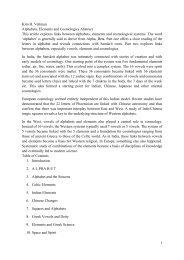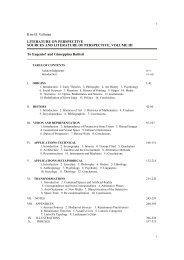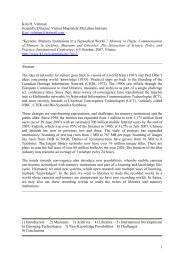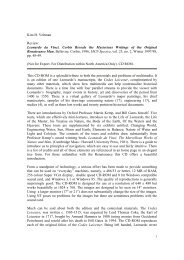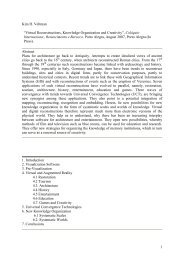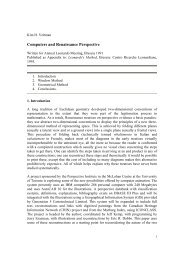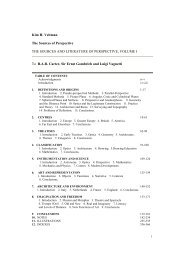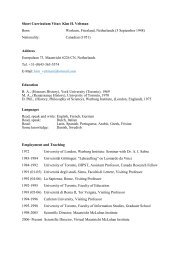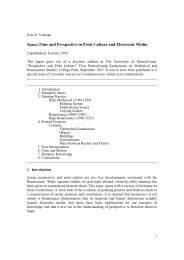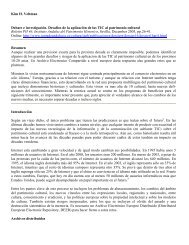1986 Perspective, Anamorphosis And Vision
1986 Perspective, Anamorphosis And Vision
1986 Perspective, Anamorphosis And Vision
You also want an ePaper? Increase the reach of your titles
YUMPU automatically turns print PDFs into web optimized ePapers that Google loves.
perspective, offers evidence that this instrument was used North of the Alps. 47 In<br />
Marolois' treatise the hemi-cylindrical projection plane recurs on its own (fig. 35).<br />
Hence the surveying tradition provided incentives for the development of both linear<br />
and cylindrical projection methods.<br />
10. Optics versus <strong>Perspective</strong><br />
Another incentive for cylindrical projection methods came from the optical tradition.<br />
Euclid in theorem 10 of his Optics had stated: “It is obvious also that planes situated<br />
higher up will appear concave" 48 . Witelo, in his twelfth century optical thesaurus,<br />
developed this statement (IV:37): “<strong>And</strong> it follows from this that with the eye raised,<br />
many a surface of a plane far from the eye will appear concave for the forms of such<br />
points tend to the eye by means of a circumference around the centre of sight because<br />
of the equality of the visual power." 49 Hence a series of points equidistant from the<br />
eye defines a concave surface. Witelo discusses it but does not draw it.<br />
Leonardo da Vinci takes up this problem in the mid 1480's (fig. 33) and discusses it in<br />
some detail in 1492. He draws (fig. 34) an eye at m looking at the objects ov and vx.<br />
The first object ov appears on the vertical picture plane as or; the second, radically<br />
smaller as re. In order to compensate for this radical change in projected size,<br />
Leonardo suggests a peep-hole (buso). 50<br />
Alternatively he recommends a curved (cylindrical) plane op which is equidistant<br />
from the eye m. 51 On this plane the objects ov and vx are projected as ot and ts. He<br />
explores this concept of a curved plane, equidistant from the eye, in several later<br />
sketches. His diagrams suggest that he intended the curved plane to be cylindrical<br />
rather than spherical. There is no firm evidence that he ever constructed either a<br />
cylindrical or a spherical plane for purposes of representation.<br />
In any case these writings confirm how Leonardo's interest in optical theory led him<br />
to explore curved projection methods as alternatives to linear perspective. He makes<br />
it clear that these alternatives only come into question under extreme conditions and<br />
recommends that these extreme conditions be avoided in order that linear perspective can<br />
be used. 52 However, he makes no attempt to reconcile his theory of vision with his theory<br />
of representation, as we might be tempted to assume he should.<br />
From a modern standpoint it is clear that the perspectival law of planes applies whether<br />
objects are higher up or off to the side. Hence in figure 36, the objects O, P, and Q, are<br />
projected equally as O, P and Q respectively because they are all in one object plane<br />
equidistant from the picture plane. Prior to Desargues (1636), however, theoreticians<br />
treated the perspectival representation of scenes as one problem, the use of optical<br />
adjustments with objects higher up as a second and objects off to the side as a third and<br />
quite distinct problem.<br />
With respect to objects higher up, Euclidean optical theory offered a pragmatic solution:<br />
an object higher up subtends a smaller angle at the eye. A higher object must therefore be<br />
made correspondingly larger if it is to subtend the same visual angle at the eye as a lower<br />
object. This reasoning appears to have evolved by the fourth century BC in Greece. 53 In<br />
the Renaissance it is implicitly introduced by Leonardo in the 1490's in a number of<br />
sketches without text. 54 Dürer publishes the problem. 55<br />
17



